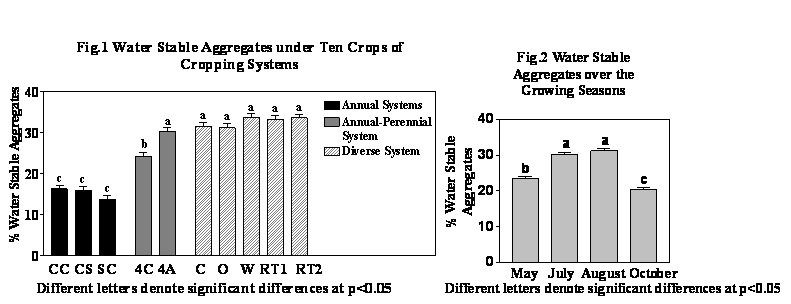
Saturday, 15 July 2006
148-18
Long-Term Effects of Cropping Systems on Soil Aggregate Stability.
Introduction: Research indicates the presence of live roots and reduced disturbance associated with perennial crops can promote soil aggregate stability. We hypothesized that including perennials and small grains in crop rotations with summer annuals would improve soil aggregate stability better than using only summer annuals in rotations. Further, soil aggregate stability would be higher in summer compared to fall or spring, when more crop roots are present.
Material and Methods: We studied 10 crops from four cropping systems that are part of a 36-year-old experiment. The experimental design was RCBD with four replications. We grouped the cropping systems into types (annual, annual-perennial, and diverse systems); and the crops into types for comparison: summer annuals (SA), winter small grains (SG) and perennials (PR) (Table 1).
| Table 1: Cropping Systems and Crops Studied Within the Cropping Systems |
| Cropping System Type | Crop Rotation | Crops Sampled | Crop Type |
| Annual
| i) Continuous corn (C-C) ii) Corn-soybean (C-S) | Corn Corn, soybean | SA SA |
| Annual-perennial | 4 years of corn- 4 years of alfalfa (4C-4A) | Year 4 of corn Year 4 of alfalfa | SA PR |
| Diverse | Corn-oats-wheat-2 years of red clover+ timothy hay | Corn | SA |
| Oats, wheat | SG | ||
| Red clover+ timothy hay | PR | ||
Twelve soil cores of 7.5 cm diameter were collected at 15 cm depth from each crop plot in the spring (25 May), summer (13 July, 22 August), and fall (31 October) of 2005. Percent water stable aggregates (WSA) were measured using standard wet sieving technique (1). Data were statistically analyzed in split plot design with time as main plots and crops as sub-plots using ANOVA of SAS. Means were compared using Tukey's test (p< 0.05).
Results and Discussion:

Soils of PR and SG did not always have higher WSA than SA (Fig.1). Soil of corn in the diverse system had similar WSA to PR and SG. Soils of PR and SG had two-fold higher WSA than SA in the annual systems and 1.3 times higher WSA than year 4 of corn in the annual-perennial system. When we compared soils of SA crops, WSA of corn soil in the annual-perennial and diverse systems was 120 and 60% higher respectively than WSA of SA of annual systems. This indicates that PR and SG had a long-term positive effect on soil aggregate stability. In soil of year 4 of corn in the annual-perennial system, WSA decreased from year 4 of alfalfa. However, WSA in corn soil of the diverse system did not decrease from the PR and SG. The WSA changed significantly with the seasons; it increased from spring to summer by 34% and then decreased in fall by 35% (Fig.2).
Conclusions: Inclusion of PR and SG improved WSA of all crops in the rotations compared to annual systems of SA alone. The WSA was highest in summer when root biomass was probably highest and lowest in spring and fall.
Back to 3.0W Sustainable Soils and Life on Land - Poster
Back to WCSS
Back to The 18th World Congress of Soil Science (July 9-15, 2006)